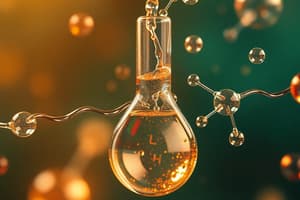Podcast
Questions and Answers
What is required for a nonspontaneous process to occur?
What is required for a nonspontaneous process to occur?
- No energy is needed
- Energy must be supplied (correct)
- It happens spontaneously
- It requires energy release
What does it indicate if the change in free energy, ΔG, is zero?
What does it indicate if the change in free energy, ΔG, is zero?
- The process is at equilibrium (correct)
- The process requires energy
- The process is spontaneous
- The energy change is negative
According to the 1st Law of Thermodynamics, what is impossible?
According to the 1st Law of Thermodynamics, what is impossible?
- Maintaining constant pressure during a reaction
- Using energy from one form completely
- Converting energy from one form to another at greater than 100% efficiency (correct)
- Converting energy at less than 100% efficiency
What does the 2nd Law of Thermodynamics state about spontaneous processes?
What does the 2nd Law of Thermodynamics state about spontaneous processes?
In the equation ΔG = ΔH - TΔS, what does ΔH represent?
In the equation ΔG = ΔH - TΔS, what does ΔH represent?
What is a key focus of the 2nd Law of Thermodynamics in biochemistry?
What is a key focus of the 2nd Law of Thermodynamics in biochemistry?
Why do cells expend energy according to the 2nd Law of Thermodynamics?
Why do cells expend energy according to the 2nd Law of Thermodynamics?
Which of the following statements is true regarding endergonic processes?
Which of the following statements is true regarding endergonic processes?
What is the function of the enzymes found in the matrix of the inner mitochondrial membrane?
What is the function of the enzymes found in the matrix of the inner mitochondrial membrane?
Which type of endoplasmic reticulum is characterized by the presence of ribosomes?
Which type of endoplasmic reticulum is characterized by the presence of ribosomes?
What is the primary role of the Golgi apparatus in a eukaryotic cell?
What is the primary role of the Golgi apparatus in a eukaryotic cell?
Which structure is NOT typically found within chloroplasts?
Which structure is NOT typically found within chloroplasts?
What distinguishes the inner mitochondrial membrane from the outer membrane?
What distinguishes the inner mitochondrial membrane from the outer membrane?
What is the approximate size of mitochondria?
What is the approximate size of mitochondria?
What is a key distinction between rough ER and smooth ER?
What is a key distinction between rough ER and smooth ER?
Which organisms are known to contain chloroplasts?
Which organisms are known to contain chloroplasts?
What is the main purpose of the Legazpi Thomasian Prayer?
What is the main purpose of the Legazpi Thomasian Prayer?
Which of the following best describes the significance of biomolecules in living organisms?
Which of the following best describes the significance of biomolecules in living organisms?
What is the primary focus of the unit 'Biochemistry and the Organization of Cells'?
What is the primary focus of the unit 'Biochemistry and the Organization of Cells'?
What key distinction is emphasized in the study of living organisms?
What key distinction is emphasized in the study of living organisms?
Which aspect of Christian social transformation is highlighted in the Legazpi Thomasian Prayer?
Which aspect of Christian social transformation is highlighted in the Legazpi Thomasian Prayer?
In biochemistry, how do living things make use of energy?
In biochemistry, how do living things make use of energy?
What does the Legazpi Thomasian Prayer ask God to sustain?
What does the Legazpi Thomasian Prayer ask God to sustain?
What is implied about the limits of individual weaknesses in the prayer?
What is implied about the limits of individual weaknesses in the prayer?
What is the relationship between monomers and polymers?
What is the relationship between monomers and polymers?
Which biomolecule is formed from amino acids?
Which biomolecule is formed from amino acids?
In the context of the genetic code, what does it relate to?
In the context of the genetic code, what does it relate to?
What does the RNA-world theory suggest about the origins of life?
What does the RNA-world theory suggest about the origins of life?
According to the RNA-world theory, what was pivotal in the origin of life?
According to the RNA-world theory, what was pivotal in the origin of life?
Which of the following best describes enzymes?
Which of the following best describes enzymes?
Which of the following statements about nucleic acids is incorrect?
Which of the following statements about nucleic acids is incorrect?
What is a primary question regarding the origin of life?
What is a primary question regarding the origin of life?
What was the original role of RNA according to the RNA-world Theory?
What was the original role of RNA according to the RNA-world Theory?
What does the Double-Origin Theory suggest about the origins of life?
What does the Double-Origin Theory suggest about the origins of life?
Which of the following statements accurately describes prokaryotic cells?
Which of the following statements accurately describes prokaryotic cells?
What is the average size range for eukaryotic cells?
What is the average size range for eukaryotic cells?
In the context of cell biology, what is a genome?
In the context of cell biology, what is a genome?
What distinguishes eukaryotic cells from prokaryotic cells?
What distinguishes eukaryotic cells from prokaryotic cells?
What is the role of organelles in a cell?
What is the role of organelles in a cell?
Which biological term refers to individual units of heredity?
Which biological term refers to individual units of heredity?
Study Notes
Spontaneity in Biochemical Reactions
- Nonspontaneous processes, also termed endergonic, require energy input to occur.
- At equilibrium, the change in free energy (ΔG) is zero, indicating no net change in the process.
- A positive ΔG (>0) signifies that a reaction is nonspontaneous and energy must be supplied.
Life and Thermodynamics
- 1st Law of Thermodynamics: Energy cannot be fully converted from one form to another without loss; energy conservation principle.
- 2nd Law of Thermodynamics: Even with perfect efficiency, complete conversion of energy is unattainable; disorder in systems increases over time.
- Free energy change relates to enthalpy (ΔH) and entropy (ΔS) through the equation: ΔG = ΔH - TΔS, where T is temperature.
- The 1st Law focuses on enthalpy changes, while the 2nd Law emphasizes entropy changes, critical for biochemistry.
- Cells expend energy to maintain structure against the natural tendency towards disorder, as spontaneous processes increase universal entropy and decrease free energy.
Cellular Structures and Functions
- The inner mitochondrial membrane has folds called cristae, creating a matrix containing enzymes for energy-yielding reactions.
- Endoplasmic Reticulum (ER) is a continuous membrane system; Rough ER has ribosomes while Smooth ER does not.
- Chloroplasts, exclusive to green plants and algae, have grana for photosynthesis and contain unique DNA.
- The Golgi apparatus consists of membranous sacs, involved in protein secretion and located near Smooth ER.
Biochemical Foundations
- All living organisms utilize the same biomolecules and energy, making biochemical processes accessible to chemical and physical study.
- Biomolecules consist of polymers formed from monomers: amino acids (proteins), nucleotides (nucleic acids), monosaccharides (polysaccharides), and glycerol with fatty acids (lipids).
- Enzymes are proteins that serve as catalysts, with their effectiveness determined by their amino acid sequence.
- The genetic code connects nucleotide sequences in nucleic acids to amino acid sequences in proteins.
Theories of Life Origin
- RNA-World Theory: Proposes RNA was the original coding molecule, able to catalyze its own processing and replication.
- Double-Origin Theory: Suggests that catalysis and coding developed independently, later integrating to form life.
Prokaryotes vs. Eukaryotes
- Prokaryotes (before nucleus): Unicellular, small (1-3 micrometers), encompass bacteria and cyanobacteria.
- Eukaryotes (true nucleus): Feature a defined nucleus with a membrane, can be unicellular (e.g., yeasts) or multicellular (e.g., plants and animals) and are larger (10-100 micrometers).
- Organelles have specialized functions and contain membranes; prokaryotic cells have only a plasma membrane, consisting of a lipid bilayer with embedded proteins.
Studying That Suits You
Use AI to generate personalized quizzes and flashcards to suit your learning preferences.
Related Documents
Description
Explore the concepts of spontaneity in biochemical reactions and the principles of thermodynamics that govern energy transformations. This quiz delves into endergonic processes, free energy changes, and the foundational laws of thermodynamics critical for understanding biochemistry. Test your knowledge on how these principles apply to living systems.




